Major festivals include Sivaratri, Vasantotsav, Ramalinga Pratishta Utsav, the divine Wedding, Navaratri, Skanda shashti and Arudra Darshan.
Puja Timings:- The temple is opened from 5.00 AM to 1.00 PM and from 3.00 PM to 9.00 PM
. 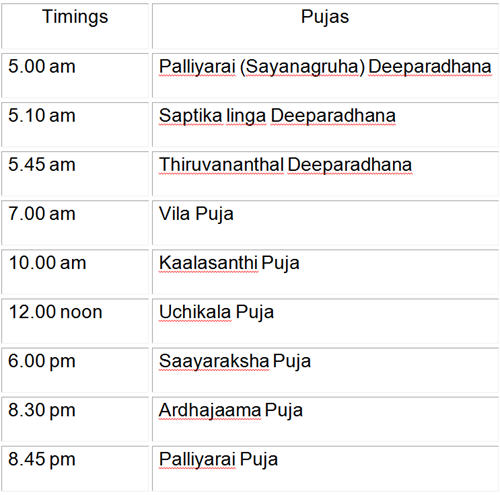
Major festivals include Sivaratri, Vasantotsav, Ramalinga Pratishta Utsav, the divine Wedding, Navaratri, Skanda shashti and Arudra Darshan.
Puja Timings:- The temple is opened from 5.00 AM to 1.00 PM and from 3.00 PM to 9.00 PM
. 
After the war of Lanka was over and Ravana was dead, Lord Ramacandra told Hanuman to go and inform Sita that the war was over and Ravana was dead. Hanuman walked freely through the pathways and came straight to Ashokavan where Sita was sitting under a tree and crying. Hanuman gave her the news and for the first time in last 10 months she became very joyful. She wanted to give many jewels and pearls to Hanuman but she had nothing. So she said, “All I have to give you is my gratitude.” Hanuman replied, “Seeing your joy is the only thing that I want.” After ten months of intense separation from her beloved, she was seeing Rama. She was very elated and she drank the beauty of Sri Rama through her lotus like eyes. Tears of ecstasy filled her eyes and her heart was overflowing with happiness.
Relationship between the Lord and His devotees are of two types: Vipralamba and Sambhoga. Vipralamba is state of separation between the Lord and His devotees and sambhoga is the state of union. Vipralamba causes one’s love for the Lord to find shelter deeper in the innermost recesses of our heart and sambhoga causes that joy to come out. The experience of the intensity of meeting is so much enhanced after separation.
Actually there can be no separation from the Lord for anyone. Lord Sri Krishna explains in Bhagavad-Gita chapter 18 verse 61,
isvarah sarva-bhutanam hrd-dese ’rjuna tisthati
bhramayan sarva-bhutani yantrarudhani mayaya
The Lord is situated as paramatma, the supersoul in the heart of every living being. The Upanishads explain that the soul and the Supersoul are like two birds sitting on the same tree. One of the birds is busy trying to enjoy the fruits of the tree and the other bird is simply observing his activities. However sinful and wretched we may become, Lord never rejects us. Even if a living entity is cast into the body of an insect, reptile or a tree, still the Lord lovingly accompanies us. But due to our own conditionings of becoming infatuated, obsessed and attached to external ego and superficial mental and physical pleasures, we have lost the ability to connect with that person who is closest to us always.
Lord comes to this world again and again to remind us that He is with us always. He speaks scriptures that give us the eternal standards of sanatana dharma. The Lord gave this knowledge to Brahma even before the creation took place. And through him the Lord taught all of us the purpose of creation and how to live in this creation. The Lord reveals through the hearts of His devotes the direction and the inspiration by which we can be reconnected with Him.
Lord Sri Krishna explains in the Bhagavad-Gita, bhaktya tv ananyaya sakya aham evam-vidho ‘rjuna, “My dear Arjuna, only by undivided devotional service can I be understood as I am, standing before you, and can thus be seen directly.”
It is not by our intelligence, our knowledge, our tapasya, our managerial skills, our physical strength, our wealth, there is no material method by which we could see God. It is possible only when the Lord by His infinite grace reveals Himself to us. Bhagavad-Gita chapter 4 verse 11 states,
ye yatha mam prapadyante tams tathaiva bhajamy aham mama vartmanuvartante manusyah partha sarvasah
The Lord reveals Himself according to our surrender, according to how we take shelter. Bhakti is that science by which we take shelter and as long as there is false ego, we cannot really take shelter. It is superficial. Bhagavad-Gita chapter 7 verse 14 says,
daivi hy esa guna-mayi mama maya duratyaya
mam eva ye prapadyante mayam etam taranti te
When we realize that without the help of the Lord there is no hope, then we can take shelter of the Lord and then the Lord reveals Himself when we approach Him with love.
Sita is the hladini shakti, the pleasure potency of the Lord. She is the source of all love. Rama or Krishna or Narayana is the Shaktiman, the Supreme object of everyone’s love. And His eternal consort is the Supreme abode of love, the supreme whole of all love. The jiva is Lord Krishna’s infinitesimal part and parcel and our love for the Lord is also part and parcel of the love of Sita, Radha or Laxmi. The greatest mystery of all the shastra is how the Supreme Lord becomes subordinate to the love of His devotees. Sridama defeats Krishna. Krishna’s expansion – Maha Vishnu creates the entire cosmic manifestation by exhaling and annihilates by inhaling. How could a little cowherd boy defeat Krishna. Krishna takes greater pleasure by being defeated by the love of His devotee. Lord Krishna who is feared by the fear personified is in fear of Yashoda mayi who was a simple gopi. This is the power of Bhakti.
Then Lord Rama told Vibhisana to go and inform Sita to take her bath, decorate herself nicely and come to see Him. Sita was very eager to meet Rama. She decorated herself nicely. They put her in a palanquin and brought her to see Rama. Rama asked Vibhisana why is Sita riding on a palanquin, she should walk on foot and this confused everyone.
So the supreme reservoir of Bhakti, Sita devi, after ten months of separation is standing before Sri Rama. It is like seeing the sun after long period of darkness. But the Lord’s expressions were very grave. He practically ignored her. She beheld the beautiful face of Lord Rama but He had no emotions on his face, total gravity. She was so confused. Everyone was looking on. They could not believe what He was doing.
Lord Ramacandra then spoke, “For the sake of demigods I have conquered Ravana and as to fulfill my dharma I have rescued you. I have no attachment for anything but dharma. Now I am going to become the king of Ayodhya and a king must be beyond all suspicion. You have spent 10 months in the house of another man. I cannot accept you back. You could stay wherever you like.” Upon hearing these words Sita fell to the ground crying. Her heart was absolutely shattered. No pain was greater than the pain of being rejected by Rama. She could not even speak. She was crying incessantly. Everyone was crying except Rama. The peak of her joy crashed down into the lowest depth of sorrow and pain. She was devastated.
She looked at Laxmana and said, “If you are not willing to accept me, if you think that I have not been chaste and faithful towards Rama. Then I will give up my life by entering into fire.” She ordered Laxmana to start the fire. Laxmana looked at Rama as if asking, “Why are You doing this?” But Sri Rama simply nodded His head, and that nod meant, “Yes Laxmana, start the fire.”
With trembling hands Laxmana collected the wood and started fire. Sita very gently circumambulated Rama and then she circumambulated fire and spoke, “If even for a moment, my mind is not in faithful and chaste remembrance of Lord Rama, then this fire burns me.” After offering her obeisances to Rama, she entered into fire. The flames were so huge that no one could see anything. Everyone began to cry; even Lord Rama broke down and began to cry.
Suddenly Agni Dev, the presiding deity of fire, appeared with Sita in his arms. She was dressed with beautiful clothes, garlanded with a mala of fresh celestial flowers. Agni deva testified, “I have tested her. She has been completely faithful and chaste. Her surrender and love is absolutely spotless. There was not a single moment when she was not having the thought of Your pure loving devotional service.”
Rama was overjoyed. He smiled tears in His eyes he accepted Sita by His loving embrace. Then Rama explained to her that He never had any doubts upon her chastity and purity. But being the king, He had to set a proper example and also He wanted to glorify Sita for her purity and chastity. Whatever sorrow that was there for those 10 months, it was gone. Demigods began to shower flowers and sang the glories of Sita and Rama.
Srimati Sita devi is the mother of the three worlds and the wife of Lord Ramacandra. Among chaste women, she is supreme, and she is the daughter of King Janaka. When Ravana came to kidnap mother Sita and she saw him, she took shelter of the fire-god, Agni. The fire-god covered the body of mother Sita, and in this way she was protected from the hands of Ravana. Upon hearing from the Kurma Purana how Ravana had kidnapped the false form of mother Sita, Sri Chaitanya Mahaprabhu became very satisfied. The fire-god, Agni, took away the real Sita and brought her to the place of Parvati, goddess Durga. An illusory form of mother Sita was then delivered to Ravana, and in this way Ravana was cheated. After Ravana was killed by Lord Ramacandra, Sitadevi was brought before the fire. When the illusory Sita was brought before the fire by Lord Ramacandra, the fire-god made the illusory form disappear and delivered the real Sita to Lord Ramacandra.” -Caitanya-Caritamrta, Madhya-lila chapter 9 verses 201-206
After bathing in Agni Teertham with wet clothes, the devotees then proceed to the temple and draw water from each of the 22 ‘tirthams’ inside the temple before arriving in front of Lord Vishwanath to offer their prayers.
Bathing in these tanks is a major aspect of the pilgrimage to Rameshwaram and is considered equivalent to penance. The waters at all these places is sweet and has a taste of its own. Every teerth has a typical story attached to it.
1. Mahalakshmi Theertham: Yudhistra took bath here and became rich and famous.
2. Savithri Theertham: Kashyapa got rid of his curse after holy dip in this theertham. Whoever takes holy dip in this theertham would get rid of all the curses.
3. Gayathri Theertham: King Kasibar got rid of his curse.
4. Saraswathi Theertham:
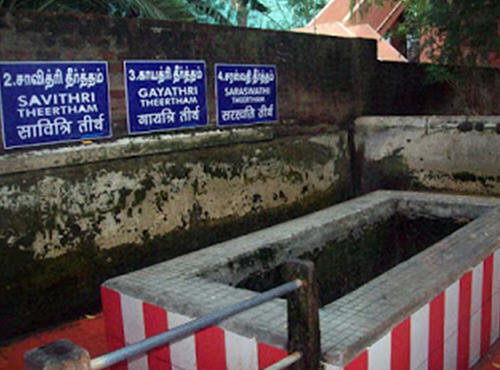
5. Sethu Madhava Theertham: Whoever takes holy dip in this water would be blessed by Mahalakshmi, their purified of impure thoughts.
6. Gandhamadana Theertham: One will get rid of their penury
7. Kavatcha Theertham: One will be protected from torture at hell.
8. Gavaya Theertham: One will be blessed to be under Kalpa Vriksha tree.
9. Nala Theertham: One will be able to take blessing of Lord Surya and reach heaven.
10. Neela Theertham: Equivalent to having performed various yajnas.
11. Sanku Theertham: Vatsanabha was freed from the sin by bathing here.
12. Brahmahathi Vimochana Theertham: Will be absolved of many sins like killing a brahmin, consumption of intoxicated drinks etc
13. Sooriya Theertham: Attain the ability to receive knowledge of the past, present and the future.
14. Ganga Theertham: Gananasuruthi Raja king attained wisdom.
15. Siva Theertham: absolving of Brahmahathi sins
16. Sadyamirtha Theertham: Anointment to many curses incurred unknowingly.
17. Sarva Theertham: Sutharishna got rid of his blindness(from birth), illness and old age and then he prospered.
18. Kodi Theertham: Lord Krishna got rid of his sin of killing his uncle, Kamsa.
It is believed that the water has several medicinal properties too and several different life threatening diseases can be cured by taking water from the different wells from this place.
One more striking feature of Ramanath swamy temple is that pilgrims also come to this temple to bathe in the various ‘tirthams’ in order to obtain spiritual merits. There are 22 ‘tirtham’ wells within the precincts of the temple. Most of the devotees take a dip first in the sea (called Agni tirtham) in front of the temple.
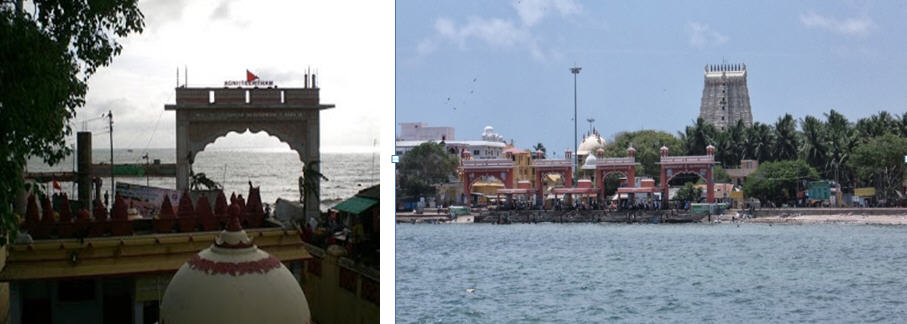

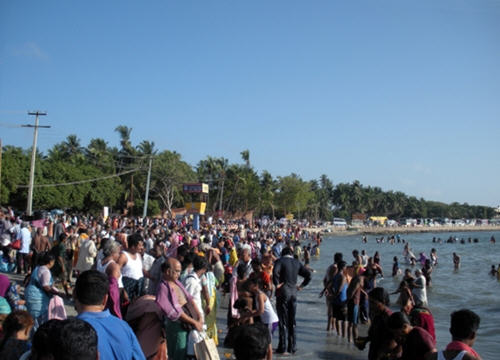
Agni Tirtham is an important holy place in Rameshwaram. After Agnideva returned Sita to Lord Ramacandra, he asked Lord Rama for a place where he could get purified because he had taken Sita away. So Lord Ramacandra asked him to take his bath in the ocean and that place came to be known as Agnitirtha. It is said that anyone who bathes in this place will develop the quality of chastity. Agni Tirtham is only 100 meters in front of the magnificent East Gopuram of the Rameshwaram Temple.
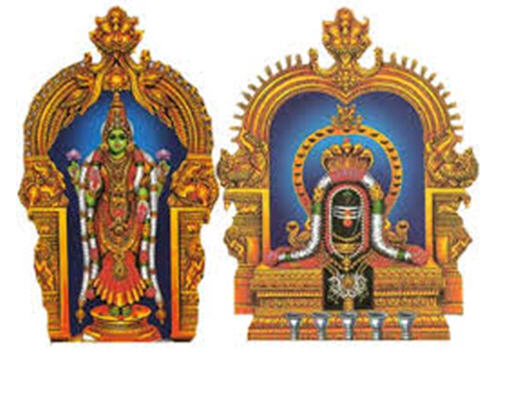
Temple is situated in the island of Rameshwaram, off the Sethu coast of Tamil Nadu and is reached via the Pamban Bridge across the sea. The huge temple is known for its long ornate corridors, towers and 36 theerthams. Ramanathswamy Jyotirlinga represents the southernmost of the 12 Jyotirlingams of India and has been a time honoured pilgrimage center held on par with Banaras (Varanasi). Rameshwaram temple Jyotirlinga is associated closely with the Ramayana and Rama’s victorious return from Sri Lanka.
The devout considers a pilgrimage to Kashi (Varanasi) incomplete unless he or she visits Rameshwaram also and performs abhisheka for Sri Ramanatha with Ganga water.
Rameshwaram temple is considered to be one of the holiest temples in India and it was built in the 17th century although construction had begun in the 12th century AD. One of the finest specimens of Dravidian architecture, the temple has gigantic dimensions. Covering an area of 15 acres, it is 264 meters to the west and 200 meters north to south consisting of three prakaras. It has the largest temple. On the tall stone pillars of temple, beautiful carvings can be seen. Elephants with their trunks raised are seen. The four sides of the temple are enclosed by strong stone walls. They are 650 ft. and 12ft. wide and tall respectively. This wonderful temple built on the sand island, is a work of great art and very impressive.
On the right side of the main shrine, Shiva’s consort Parvati has her own temple.
The Ramayana narrates the story of Lord Rama, who declared war against the powerful Ravana, the King of Lanka who had abducted Rama’s wife Sita. In the fierce battle that ensued, Ravana was defeated and killed by Lord Rama. When Sita was released from Ravana’s prison, as per the Sthala Mahatmya (local legend), Sita and Ram on Their way back to Ayodhya stopped at the island of Rameshwaram which was then called ‘Gandhamadhana Malai ‘.
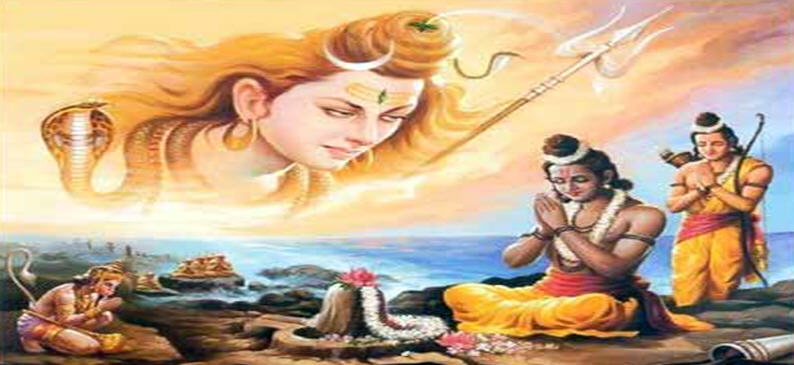
Here Agatsya Muni and other rishis were praising Lord Ramacandra for His greatness. At that time Lord Ramacandra told them that “even though Ravana was a rakshasa, he was the grandson of Brahma and the son of a great Brahman Visrava. I must atone for the sin of killing Ravana.” There was no need for the Lord to perform such atonement. But it was His noble, humble nature.
The sages told Lord Ramacandra that Ravana was a great devotee of Siva, who gave him great benediction. So you should perform pooja to Lord Siva. You should get a Siva lingam from Kailash and worship that Siva linga. So Lord Ramacandra told Hanuman to get a Siva linga from Kailash. Hanuman went to Kailash and began to perform tapasya. But it was getting late and the auspicious time for the pooja was passing. So Sita devi with her own hands, made a Siva linga out of sand. Lord Ramacandra performed pooja to the Siva linga made by Sita devi. At that time Hanuman returned with the Siva linga from Kailash but he felt very sad that he could not serve Lord Ramacandra. Lord then told Hanuman that he could remove this Siva linga made by Sita devi and place the Siva linga that he has brought from Kailash. Hanuman tried to remove the Siva linga but he was unsuccessful. He wrapped his tail around the linga and jumped but Siva linga didn’t move. Hanuman lifted mountains but he could not move a Siva linga. Hanuman was humbled and he understood that all the strength of the devotees is coming from Srimati Sita devi.
Then Lord Ramacandra told Hanuman that you install your Siva linga next to Sita devi’s and I command all My devotees that they should first worship the Siva linga brought by you and then they should worship the Siva linga made by Sita devi. At that time Lord Siva and Parvati appeared and proclaimed that anyone who bathes in Dhanushkoti and then worships me here, I will liberate them.
Srimad-Bhagavatam Canto 12 chapter 13 verse 16 describes “vaisnavam yatha sambhuh”, that Lord Siva is the greatest Vaishnava. When Lord Ramacandra worshipped Siva that was an expression of His love towards His devotees. Similarly Lord Sri Krishna worshipped Sudama vipra and Lord Sri Caitanya Mahaprabhu danced before the deity of Lord Siva. Lord explains, mad-bhakta-pujabhyadhika, that worship of My devotee is better than worshipping Me directly. Lord Ramacandra taught us by His own example that how even He is eager to be the servant of the servant of the servant of His devotees.
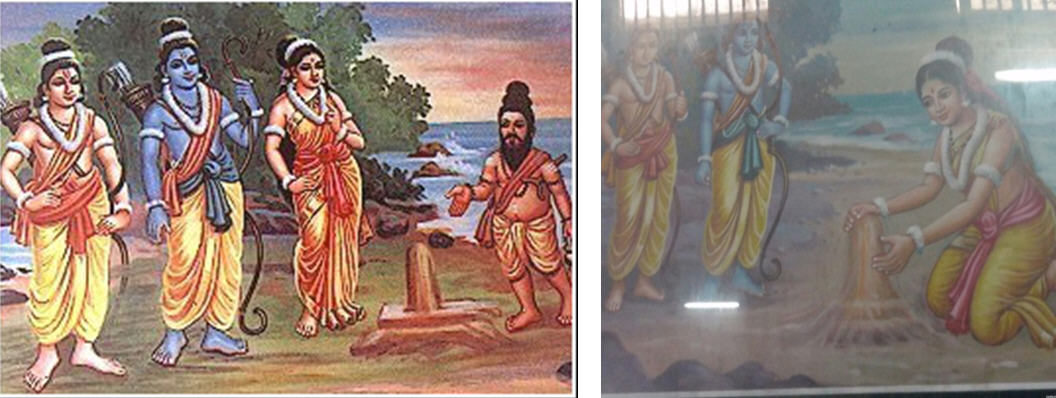


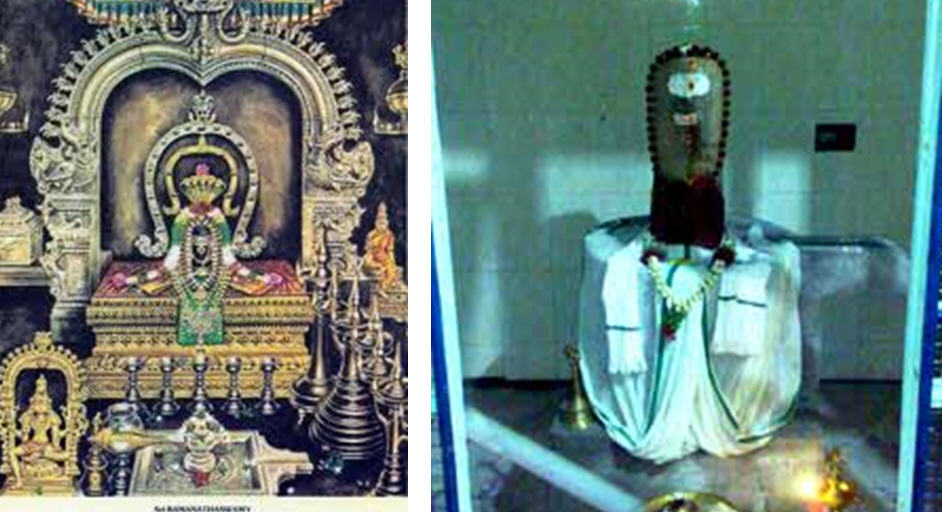
There is another Sphatika-linga which was installed by Vibhishan. Abhishek & deeparadhana are performed to this lingam daily at 5 am.

The other striking feature of this temple is that the corridors are said to be the longest in the world. The outer wing of the corridor measures 690 ft in the east-west direction and 435 ft in the north-south direction. There are a total number of 1212 pillars or columns each sculptured to a similar profile and these frame the corridor on either side. The height of this corridor is 22 ft and when viewed from the corner where the north or south side corridors meet the west or east side corridors, the sight is breathtaking.